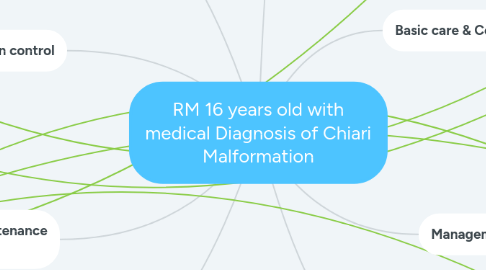
1. Make sure check for sign and symptoms of infection
1.1. check surgical site for infection
1.1.1. Related to new surgical repair on Chiari malformation last week.
1.1.1.1. Evidenced by urine Stasis and urine specific gravity
1.2. Access IV site
1.2.1. Check for any sign and symptoms of infection
1.2.1.1. check for redness and swollen in the IV site
2. Reduction of Risk potential priority
2.1. Maintain Adequate Airway, Breathing
2.1.1. Make sure that Pt has Adequate Airway, Breathing and Circulation by assessing changes in mental status.
2.1.1.1. Adequate Airway, Breathing and Circulation are essential for patients. we must establish adequate ABC.
2.2. Monitor Electrolyte
2.2.1. Closely monitor Na, K
2.2.1.1. Hypokalemia can lead to cardiac dysrhythmia
3. Safety and Infection control
3.1. Make sure we educate parent about contact precaution
3.1.1. Provide education to wear gloves and gown while care for this patient
3.1.1.1. Allow time for parent and caregiver to teach back how to down off and on
3.2. Teach Parents hand hygiene
3.2.1. This intervention would prevent spreading infections
3.2.1.1. Allow time for teach back method to ensure that teaching have been effective.
3.3. Risk for fall
3.3.1. Related to pain, discomfort and balance problem
3.3.1.1. Evidenced by patient unable to ambulate greater than 10 feet due to lack of coordination
4. Health Promotion & Maintenance Priority
4.1. Educate parents regarding new medical diagnosis
4.1.1. Related to Chiari malformation is rare genetic disorder that effect less than 0.1 % of population.
4.1.1.1. Educate Patient to seek consuling regarding their child mew medical diagnosis
4.2. Educate patient's family how to look for sign and symptoms surgical infection
4.2.1. Its curial to detect early sign and symptom of surgical infection .
4.2.1.1. Educate Patient to seek care if notice any changes in alerted mental status or redness or swollen noticed at surgical site
5. Basic care & Comfort Priorities
5.1. Elevated the head of the bed
5.1.1. Related to lung expansion
5.1.1.1. Evidenced by decrease respiratory rate of 16 per minutes
5.2. Allow Parents to assist with patient care
5.2.1. Related to decrease anxiety and increase comfort
5.2.1.1. Evidence by decrease anxiety and increase comfort.
5.3. Provide education to parents and Patient
5.3.1. Related to recent medical diagnosis
5.3.1.1. Evidenced by teach back method
6. Pharmacological
6.1. Pain Medication around oclock
6.1.1. To improve patient comfort level
6.1.1.1. Patient was in lots of pain evidence by nonstop crying and facial griming. decrease pain level by providing pain medication on time
6.2. Decrease stimulus
6.2.1. Related to increase to Look it up hypersensitivity and photophobia
6.2.1.1. Patient did not tolerate walk in the hallway because light bothered her
6.3. Zofran
6.3.1. To prevent nausea and vomiting's
6.3.1.1. Patient complaint of nausea and vomiting.
6.4. Laxatives'
6.4.1. To promote GI emptying
6.4.1.1. Patient is receiving opioid medication, one the side effect of opioid is constipation
7. Management of Care priority
7.1. Check for Airway, Breathing, Circulation.
7.1.1. Continuous plus oximeter
7.1.1.1. Listen to lung sound assess cardiac monitor, monitor BP and capillary refill.
7.2. Evolve Parents in care management
7.2.1. By allowing parents to help us with simple task
7.2.1.1. Evolving parents is great way for parent to feel that they are doing some proactive for their child.
7.3. Evaluative Head of The Bed
7.3.1. To prevent Aspiration related to vomiting and Nausea
7.3.1.1. Patient complaining of vomiting and nausea. Vomiting can cause aspiration pneumonia.
8. Physiological Adaptation Priorities
8.1. Acute Pain
8.1.1. Related to recent surgery
8.1.1.1. Evidence by patient facial expression and discomfort
8.2. Risk for punoseudous
8.2.1. Related to CSF Fluid leak
8.2.1.1. Evidenced by small empty cavity in the back of her head
8.3. Potential risk for infection
8.3.1. Related to surgical sites and IV management
8.3.1.1. Evidence by frequent continues IV pump
8.4. Impaired Skin Integrity
8.4.1. Related to recent surgery
8.4.1.1. Evidenced by eviscerations of occipital area laceration
